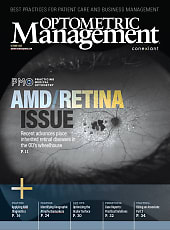Brainstorming for Improvement
Want to make your practice better? Get your staff in on the act.

Looking
for ways to attract new patients or reactivate former ones? Reduce operating costs?
Increase the dispensing of prescription sun wear or tinted contact lenses? A brainstorming
session with your staff may provide some answers. This
method for developing ideas was originated by Alex F. Osborn, founder of the famous
Batten, Barton, Durtsine and Osborn Advertising Agency. He called it "brainstorming."
Its basic principle is that no one person can have all the ideas, but one person's
ideas can spark a chain reaction. A problem is presented to a group of experienced
people who collectively use their ingenuity and imaginations to find solutions.
In his classic text on the subject,
"Applied Imagination," Mr. Osborn states four ground rules for success:
►Criticism is ruled out. Withhold adverse judgment until later.
What you don't want The worst position to be in when it comes to ideas
is to have too few of them. That's why the primary rule of brainstorming is to amass
quantity, not force quality. Unfortunately, many people forget this rule. They ask
for ideas, stifle the conversation by judging each idea as soon as it's mentioned,
and then wonder why their staff does not brainstorm well. If you want ideas to improve
your practice, you need to generate lots of ideas and consider them all — even
the ones that are too costly, time-consuming, or outrageous.
Creativity is messy. The best ideas
never appear fully formed and practical. They're often hidden inside an idea that
is impractical and silly. These best ideas need to be coaxed, nurtured and defended.
Creating an environment that encourages creative thinking isn't always easy, but
it's usually fun.
Now take action A brainstorming session should be conducted in
a relaxed environment. If participants feel free to joke, they'll stretch their
minds and produce more creative ideas.
A brainstorming session requires a
facilitator to get the proceedings started and steered in the right direction. He
or she should encourage participation, see that everyone is heard, and maintain
the tempo and enthusiasm.
You'll also need a scribe to keep track
of the ideas on a white-board or flip chart that's visible to all.
Limit the sessions to 25 to 30 minutes,
although more or less may be necessary depending on the size of the group and the
flow of ideas.
The most important element of a brainstorming
session is the spirit in which you conduct it. It should be friendly and uninhibited.
Laughter is encouraged. Criticism is not.
The hardest thing to accept is the
complete suspension of critical judgment and negativity. The group can think creatively
or it can think critically. If the group tries to do both at once, the inhibiting
effect will stifle the flow of ideas. Avoid at all costs what I call "idea killers"
such as, "We tried that once before...," "That won't work in this practice..."
Important action step: Whenever possible,
implement changes in office policies and procedures by consensus. People tend to
be more supportive of decisions in which they have some input, such as those that
result from brainstorming. And they're more interested in seeing a successful outcome
than they are in decisions made by others and passed along to them.
BOB LEVOY'S NEWEST
BOOK, "201 SECRETS OF A HIGH PERFORMANCE OPTOMETRIC
PRACTICE" WAS PUBLISHED BY BUTTERWORTH-HEINEMANN.
YOU CAN REACH HIM BY E-MAIL AT B.LEVOY@ATT.NET.
►Freewheeling is welcomed. The wilder the idea, the better. It's easier to tame down
than to think up.
►Quantity is wanted. The greater the number of ideas, the more likelihood one will
be useful.
►Combination and improvement are sought. In addition to contributing ideas of their
own, participants should suggest how the ideas of others can be turned into better
ideas; or how two or more ideas can be joined into still another idea.



